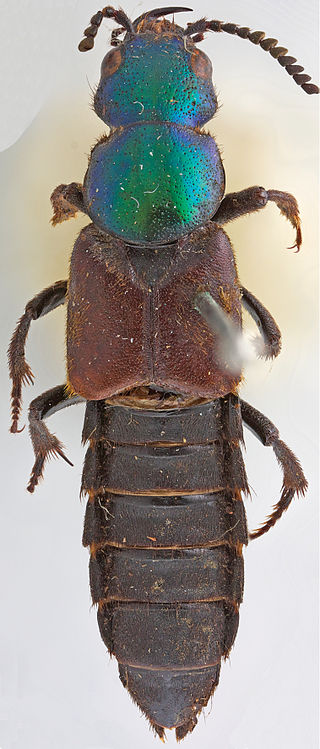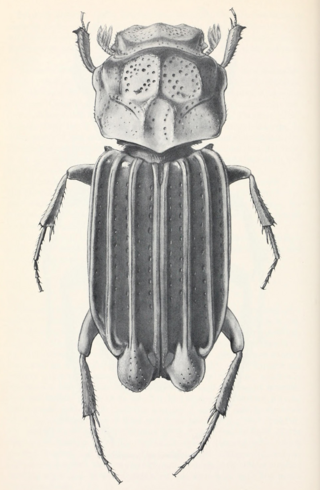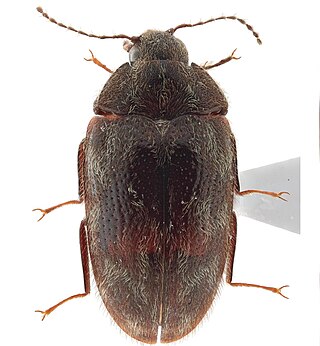
Prionomyrmex is an extinct genus of bulldog ants in the subfamily Myrmeciinae of the family Formicidae. It was first described by Gustav Mayr in 1868, after he collected a holotype worker of P. longiceps in Baltic amber. Three species are currently described, characterised by their long mandibles, slender bodies and large size. These ants are known from the Eocene and Late Oligocene, with fossil specimens only found around Europe. It is suggested that these ants preferred to live in jungles, with one species assumed to be an arboreal nesting species. These ants had a powerful stinger that was used to subdue prey. In 2000, it was suggested by Cesare Baroni Urbani that the living species Nothomyrmecia macrops and a species he described both belonged to Prionomyrmex, but this proposal has not been widely accepted by the entomological community. Instead, scientists still classify the two genera distinctive from each other, making Nothomyrmecia a valid genus.

Darwinilus sedarisi is a species of rove beetle, the only species in the genus Darwinilus. It is named after Charles Darwin and David Sedaris. It is found in Argentina. A specimen of the beetle was collected by Charles Darwin in 1832 during the voyage of HMS Beagle, but not formally named as a new species until 2014.
Cyclocephala nodanotherwon is a species of rhinoceros beetle in the scarab family. It has only been found in Amazonas, Brazil. Brett C. Ratcliffe described and named the species in 1992.

Colilodion schulzi is a species of beetles belonging to the family Staphylinidae. This small, robust, reddish-brown rove beetle is known from a single specimen, a 2.37 millimetres (0.093 in) long female. It resembles the species C. concinnus and C. inopinatus with its enlarged antennomeres III, but it is easily distinguished by the greater maximum width and less variable width of these appendages, and by other morphological characteristics. Although its ecology is unknown, the presence of trichomes and the knowledge of related species, such as Staphylinidae suggests that this insect is myrmecophilous. The holotype was collected in 2009 in Palawan (Philippines) while sifting plant debris in a coniferous forest. The species was described in 2016 by the coleopterists Zi-Wei Yin from Shanghai Normal University and Giulio Cuccodoro from the Natural History Museum of Geneva, where the type specimen is part of the collection. The taxon's specific denomination is dedicated to the German myrmecologist Andreas Schulz, collector of the specimen.

Mecodema kokoromatua is a medium-bodied ground beetle endemic to Northland, New Zealand. Its range is restricted to coastal forest behind the sand dunes and below the southern areas of the Ahipara Escarpment, Herekino, Northland, New Zealand. This species is within the curvidens species group and is related to the geographically widespread M. parataiko.

Cartwrightia cartwrighti is a species of aphodiine scarab found in South America. Oscar L. Cartwright named the species in 1967 after his brother. C. cartwrighti has been recorded in cow dung in pastures and forests.

Limnichidae, commonly called minute marsh-loving beetles, is a family of beetles belonging to Byrrhoidea. There are at least 30 genera and 350 described species in Limnichidae. They are found worldwide, with the greatest diversity in tropical regions. Most species seem to be associated with water-adjacent habitats, such as riparian and coastal locations, though many species are likely fully terrestrial, with some species being associated with leaf litter and arboreal habitats. Species with known diets feed on moss or algae. The oldest fossils of the family are known from mid-Cretaceous Burmese amber from Myanmar.

Tarsostenus is a genus of checkered beetles in the family Cleridae. It includes the cosmopolitan species T. univittatus.
Coelostoma (Holocoelostoma) stultum, is a species of water scavenger beetle widely distributed in Palearctic and Oriental realms from West Pacific towards Indian Ocean, such as China, Taiwan, Andaman Islands, Myanmar, India, Indonesia, Japan, Korea, Malaysia, Mascarene Islands, Nicobar Islands, Oman, Philippines, Saudi Arabia, South Korea, Sri Lanka, Thailand, United Arab Emirates, Oman, and Vietnam.
Phaeochrous elevatus, is a species of scavenger scarab beetle native to South India and Sri Lanka.
Arixyleborus mediosectus, is a species of weevil found in India, Sri Lanka, Cambodia, Myanmar, Philippines, Malaysia, Indonesia: Sumatra and Vietnam.
Clambus ceylonicus, is a species of fringe-winged beetle endemic to Sri Lanka.
Sceloenopla octopunctata, is a species of leaf beetle found in India and Sri Lanka.

Caccothryptus larryi is a species of minute marsh-loving beetle in the subfamily Limnichinae. The species was described alongside five other Caccothryptus species by Natural History Museum entomologist Keita Matsumoto in 2021, using specimens gathered in 1953 by Harry George Champion in Haldwani, India. Both of the c. larryi specimens featured genital structures distinct from Champion's initial classification of C. ripicola. The species was named for Larry, the Chief Mouser to the Cabinet Office at the British Prime Minister's residence at 10 Downing Street.

Caccothryptus tardarsauceae is a species of minute marsh-loving beetle in the subfamily Limnichinae. The species was described alongside five other Caccothryptus species by Natural History Museum entomologist Keita Matsumoto in 2021, using a male specimen gathered in 1953 by Harry George Champion in Haldwani, India. One of Champion's specimens was distinguished from its initial classification of C. ripicola due to distinct genital structures. The species was named for Tardar Sauce, also known as Grumpy Cat, a pet cat which had become an internet celebrity prior to her death in 2019.

Caccothryptus arakawae is a species of minute marsh-loving beetle in the subfamily Limnichinae. The species was described alongside five other Caccothryptus species by Natural History Museum entomologist Keita Matsumoto in 2021, using specimens gathered by Martin J. D. Brendell at Kathmandu, Nepal in 1983. Six of Brendell's specimens were distinguished from its initial classification of Caccothryptus testudo due to distinct genital structures. The species was named for Hiromu Arakawa, the creator of manga series Fullmetal Alchemist.

Caccothryptus brendelli is a species of minute marsh-loving beetle in the subfamily Limnichinae. The species was described alongside five other Caccothryptus species by Natural History Museum entomologist Keita Matsumoto in 2021, using specimens gathered by Martin J. D. Brendell at Kathmandu, Nepal in 1983. One of Brendell's specimens were distinguished from Caccothryptus testudo due to distinct genital structures and labeled C. brendelli after Brendell.

Caccothryptus championi is a species of minute marsh-loving beetle in the subfamily Limnichinae. The species was described alongside five other Caccothryptus species by Natural History Museum entomologist Keita Matsumoto in 2021, using specimens gathered in 1953 by Harry George Champion in Haldwani, India alongside an earlier 1925 specimen collected nearby. Like the other Caccothryptus species described by Matsumoto, it was distinguished from its original classification of C. ripicola due to differences in the shape of its genitalia. Twenty-seven specimens from the British Natural History Museum collection were identified with C. championi, named after Champion.
Caccothryptus yunnanensis is a species of minute marsh-loving beetle in the subfamily Limnichinae. The species was described in 2018 by enomologist Hiroyuki Yoshitomi. Although part of the species group C. testudo, it is related to the C. compactus species C. chayuensis) and C. thai due to serrae due to their shared small notches along the median lobe. It is distinguished from these due to its straight parameres, which are curved in C. chayuensis and C. thai. C. yunnanensis specimens were collected by Yu-Tang Wang across the Chinese provinces of Guizhou and Yunnan, the latter of which gave the species its name. It is almost entirely black in coloration, except for dark and light brown in its antennae and legs. It has an average length of around 5 mm. The holotype of C. yunnanensis is a male collected in Xima, Yunnan in 2014.
Caccothryptus is a genus of minute marsh-loving beetle in the subfamily Limnichinae. The genus was first described by entomologist David Sharp in 1902, with C. compactus as the type species.












